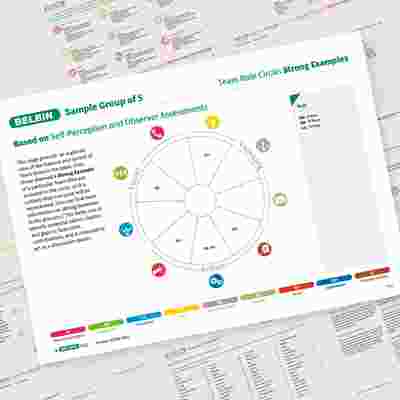The Five Dysfunctions of a Team - A Leadership Fable
In his bestselling book, The Five Dysfunctions of a Team - A Leadership Fable, Patrick Lencioni described the pitfalls that can spell a team’s downfall.
Here, we take a look at these five dysfunctions and examine how Belbin and the Lencioni model can mitigate a team’s problems and pave the way for success.

1. Absence of trust
Lencioni claimed that teams who were unable to be 'vulnerable' with one another encountered problems. These teams were unwilling to admit mistakes, acknowledge weaknesses or ask for help.
In order to be open with one another in this way, individuals need psychological safety: to know that they can share the negatives of their experiences without fear of recriminations.
Opening up can be the most difficult part
In 2016,Google’s Project Aristotle – their research into effective teams – named ‘psychological safety’ as the single most important ingredient for team success.
But opening up can be the most difficult part.
Identifying and communicating our Belbin Team Roles – the behaviours we tend to adopt in a team – encourages individuals to share preferences and discuss past mistakes and shortcomings within a protective and positive framework.
The first step is for team members to receive their Belbin Individual Reports. These describe each person’s unique combination of Team Roles (using responses from the individual and the rest of the team) and offer guidance and advice on how to play to your strengths.


Unlike many theories, for Belbin, weaknesses aren’t a subject to be avoided.
We talk about ‘allowable weaknesses’ of a particular Team Role as simply flipsides of a Team Role strength. In other words, they’re a trade-off for playing a particular role to good effect – shortcomings which, when known, can be mitigated by others in the team.
The data from Individual Reports can be aggregated to produce Belbin Team Reports. These analyse the team as a whole, showing where each team member fits and how approaches to work might differ. The clarity of contributions Belbin offers can aid team development and help members understand why co-workers might respond to failure in a certain way.
Understanding the underlying behaviour can help the team to process it
Lencioni gives the example of someone admitting, “Your idea was better than mine”.
- For a Plant, who makes a significant investment of time and energy into a new idea, this can be a difficult statement to make.
- It can take a lot for a proud Shaper to apologise.
- An anxious Completer Finisher who has let a mistake slip through the net is likely to be punishing themselves rather than sharing the failure with the team.
In each case, understanding the underlying behaviour can help the team to process it, modify their approach to the individual, build bridges and move on.

2. Fear of conflict
Where trust is lacking, key issues cannot be debated effectively, because individuals stand to lose too much from the fallout.
Lencioni claims that conflict is simply an attempt to find the best possible solution in the shortest possible time, and that successful teams thrive on engaging in discussions about important topics.
Understanding the motivations behind words spoken
Research shows that artificial harmony doesn’t necessarily help teams move forward. Professor J. Richard Hackman, late Edgar Pierce Professor of Social and Organizational Psychology at Harvard University, discovered that disagreements were good for a team, so long as they were handled well and focused on the team’s objectives.
In Belbin terms, it can help to understand how different people perceive conflict.
- For the driven, forceful Shaper, confrontation is a part of life – and not an uncomfortable one. For the Shaper’s Team Role opposite, the sensitive, diplomatic Teamworker, however, conflict is to be avoided at all costs, because it creates an unpleasant team dynamic and risks damaging relationships between team members.
Belbin also helps us to appreciate each person’s starting-point in a discussion.
- There’s the Monitor Evaluator, who seeks to arrive at the right decision through impartial, academic debate.
- The Implementer digging their heels in to avoid changes which threaten their way of working.
- The Specialist who feels that their expertise is being undermined.
Understanding the motivations behind words spoken in the heat of the moment can help to depersonalise conflict, allow individuals to engage constructively with one another and keep discussions on track.
"Not finance. Not strategy. Not technology. It is teamwork that remains the ultimate competitive advantage, both because it is so powerful and so rare."
Patrick Lencioni | The Five Dysfunctions of a Team
3. Lack of commitment
Without conflict, team members do not arrive at decisions, so plans are ambiguous or out of line with the team’s objectives. This lack of direction can harm engagement, since individuals don’t know where they fit in the grand scheme of things.
Commitment doesn’t necessarily come from complete consensus, Lencioni tells us. But a functioning team should have ‘buy-in’ from everyone, even those who initially disagreed with the proposal.

An understanding of Team Role behaviours
- Someone with strong Co-ordinator propensities can ensure that everyone’s voice is heard and facilitate the decision-making process, so that individuals can work with the outcome, whatever it may be.
- With sufficient trust, the team’s resident Plant can acknowledge disappointment that another idea was not taken forward.
- The Completer Finisher can register concern that the schedule will not allow for sufficient checking.
With an understanding of the Team Role behaviours which prompt their comments, their concerns are likely to be understood and addressed, rather than dismissed as 'sour grapes' or sheer negativity.

4. Avoidance of accountability
In teams that are lacking accountability, individuals tend not to confront each other with concerns, whether in terms of behaviour or performance.
It can be difficult to broach these kinds of conversations.
Team members hold one another accountable in a constructive fashion
However, in a team where individuals are fully aware of their strengths and weaknesses – and used to ‘auditing’ useful team behaviours on a regular basis – these conversations can be approached consistently and handled in the right way.
For example, a Resource Investigator might be challenged for failing to follow up clients and letting people down.
Belbin provides the language to address the problem (this failure to follow up is a flipside of the Resource Investigator’s enthusiasm for new projects) but also hints at strategies to enable individuals to manage strengths more effectively.
In this example, the follow-up could be handed over to another team member (perhaps with Implementer and Completer Finisher strengths) at an agreed point, to ensure that clients’ needs are met.
With both team members working to their strengths, each is likely to be more engaged and high performance is more likely.
When team members hold one another accountable in a constructive fashion, they build trust and mutual respect, and assume more responsibility for the team’s endeavours.
5. Inattention to results
When people are not held accountable, there is a tendency for individuals to put their needs and priorities ahead of the team’s collective goals.
When the team loses sight of the need to achieve, the business suffers as a result.

No one Team Role is better than another
No one Team Role is better than another, and everyone has something to offer.
Belbin helps individuals to understand what they – and their colleagues – can contribute, and how each contribution helps the organisation as a whole.
With each person playing to their strengths, individual aspirations and goals are pulled into line with the group’s objectives, so that everyone benefits when the team succeeds.
"Team success depends to a great extent on having members who set team goals above those of personal self-interest."
Dr Meredith Belbin | Management Teams 3rd Edition
A work in progress
Lencioni points out that it is difficult to ‘master’ these five dysfunctions, because a team’s situation is always changing.
With new members, a change in leadership, or new goals, the team may have to begin again with establishing trust.
Perhaps you have a high performing team, but you’re striving for more? Perhaps the team finds itself at breaking-point, ridden with conflict and turmoil? Maybe it is suffering from a little apathy and just needs a boost?
Whatever your situation, the language of Belbin Team Roles meets teams where they are, and provides the tools needed to help it grow.
Complete the form below and we'll show you what Belbin can do for you and your team.
Request a Demo
Let's explore how Belbin can help transform your teams.
Discover individual and team strengths using Belbin Team Role reports

Belbin Individual Reports
Before you can analyse your teams, you need to look at each individual's contribution. So, the first thing you will need to do is to generate a Belbin Individual report for each member of the team.
Find out more
Belbin Team Reports
Whether you're forming a new team, introducing new people to an existing team, or trying to resolve issues within a team, a Belbin Team report can help you to manage it.
Discover more
Why Use Belbin?
Belbin Team Roles are used to identify behavioural strengths and weaknesses in the workplace. Whether developing people, resolving conflict or fine-tuning high performance...
Read more